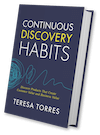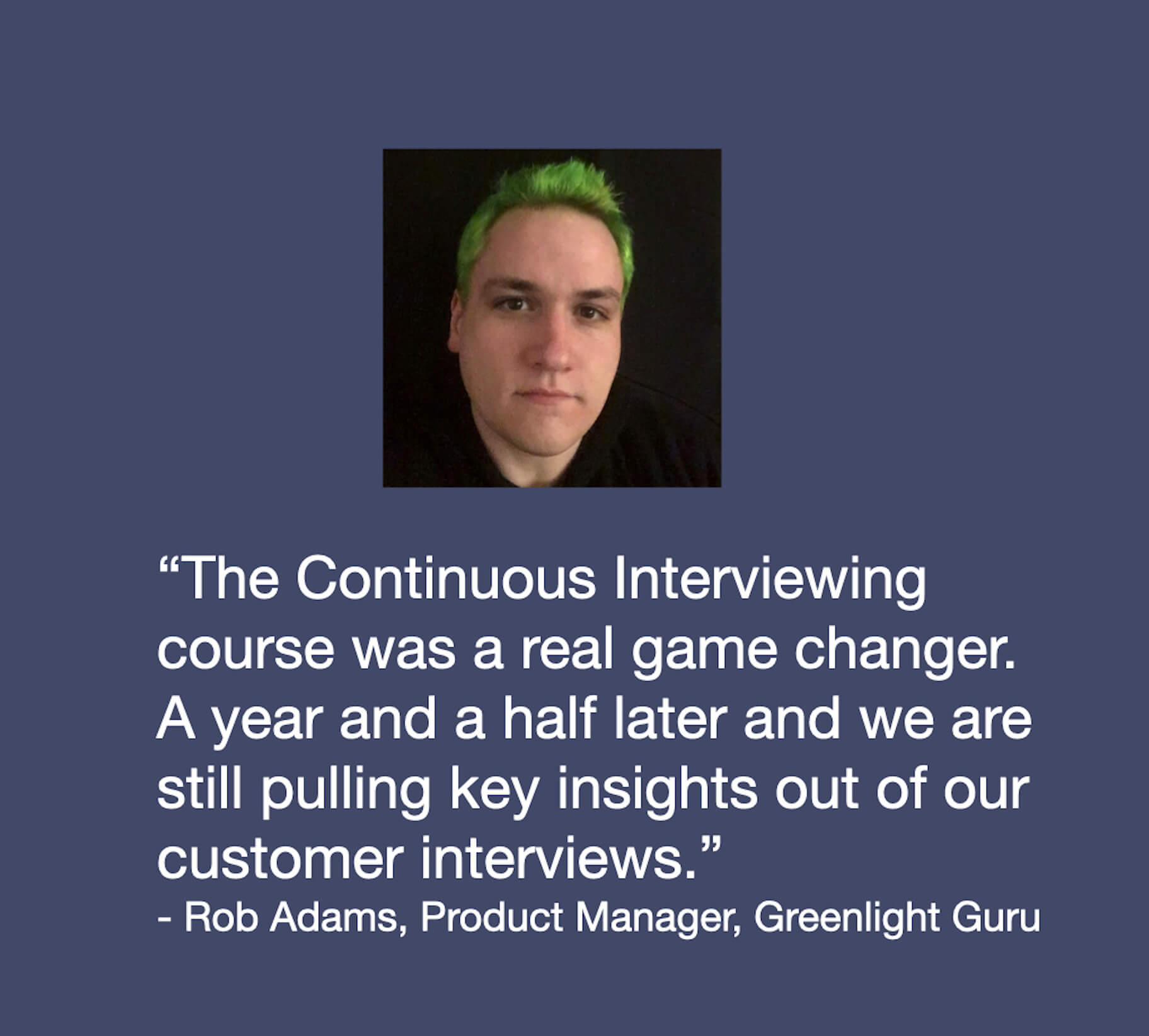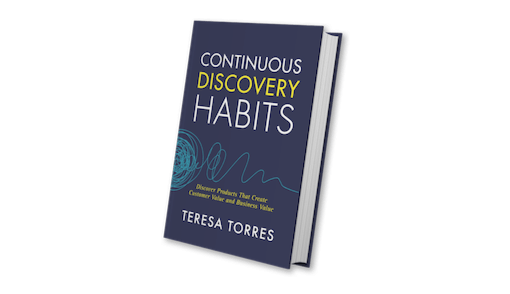 Have you heard? My new book Continuous Discovery Habits is now available. Get the product trio's guide to a structured and sustainable approach to continuous discovery.
Have you heard? My new book Continuous Discovery Habits is now available. Get the product trio's guide to a structured and sustainable approach to continuous discovery. Happy New Year!
I’m excited for 2022. Every December, I take several weeks to reflect on the ending year and to look forward to the year ahead.
For the past few years, I’ve shared my reflection and plans in the first post of the year. This year is no different.
2020 and 2021 brought many changes to my business. Some were driven by the tumultuous change that we are all experiencing as COVID-19 rages across the world. Some were the result of me continuing to be intentional about designing a business that I want to run for the rest of my life.
I’ve had time to try out those changes, and today, I’m excited to announce my plans for the year.
First, let’s look at the outcomes that drive my business.
Understanding Impact vs. Outcomes

Increasing the number of product trios who adopt a continuous cadence to their discovery work is my North Star metric.
My goal is to increase the number of product trios who adopt a continuous cadence to their discovery work. This won’t surprise any of you.
This has been the North Star metric that has driven my coaching practice since I started.
There’s just one problem. I have no idea how to measure this metric. So while this is the impact I hope to have, it’s not the outcome I focus on.
My goal is to increase the number of product trios who adopt a continuous cadence to their discovery work. While this is the impact I hope to have, it’s not the outcome I focus on. – Tweet This
Instead, I have defined a set of business outcomes and product outcomes that are far more actionable.
I teach teams that business outcomes are derived from your business model. Product outcomes measure your customers’ behavior within the product and are leading indicators of business outcomes.
Business outcomes are usually centered around increasing revenue or impact. If you align revenue with creating value, then revenue is a proxy for measuring impact.
Business outcomes are usually centered around increasing revenue or impact. If you align revenue with creating value, then revenue is a proxy for measuring impact. – Tweet This
For Product Talk, historically, my primary business model was based on selling discovery coaching to companies. My business model formula looked something like this:
# of teams in my coaching program x price per team
This business model formula is a very simple way of looking at how I could increase revenue for my business. Increasing the number of teams that I coach would increase both revenue and impact. However, increasing prices would only increase revenue. We’ll return to this concept a little later.
Discovery Coaching Doesn’t Scale
However, this business model is limited by my time. I can only work with so many teams at once. I learned through trial and error that in order for me to do my best work, I should work with no more than ten teams at a time. I worked with teams in cohorts, ten teams in a cohort, three cohorts in a year. From 2015–2019, I was pretty much maxed out all the time. I always had a waiting list.
I probably could have squeezed a fourth cohort in there, growing my capacity from 30 teams to 40, but I knew this wouldn’t leave me time to iterate on my curriculum, write blog posts (not to mention a book), or anything else. I wasn’t willing to increase my capacity here. So that meant my only lever was to increase my price.
From a revenue standpoint, that’s not a bad place to be. In fact, it allowed me to rely on scarcity to close business quickly. I optimized my sales funnel, selling most of my coaching via email—a key benefit for an introvert who doesn’t love being on the phone all day. But it doesn’t increase impact.
While I was making a good living, I was anxious to have more impact. I felt stuck by the capacity limitations of my business model. I didn’t want companies to have to wait so long for coaching. I wanted to help more than 30 teams each year. I coach product trios, so 30 teams typically means 90 people. It didn’t feel like enough. So I started to experiment.
In 2017, I launched my first online course, Continuous Interviewing. In 2018, I partnered with Hope Gurion to expand my coaching capacity. And in 2020, I launched my membership community. The first two have been tremendously successful experiments and have helped me completely reshape my business. The third, while still a nascent business, is one of the most fun things I’ve ever created.
Online Courses Unlock Scale

Here’s one review from a Continuous Interviewing course participant. I’ve quickly learned how courses allow me to scale my business and my impact.
I had 50 students in my first cohort of Continuous Interviewing. The course ran for four weeks. At the end of the course, students said they felt confident they could collect a reliable story from their customers.
This blew my mind. This was the scale I was missing in my business. It was also a ton of fun. I’m a teacher at heart and I loved working with students who chose to take my course.
That last bit is an important dynamic. While the vast majority of teams that I coached were thrilled to get coaching, in every cohort there was always one or two teams who didn’t want to be there. Their boss told them to participate and they didn’t see the point. These teams were utterly soul-crushing for me. I rarely saw this happen in my courses.
So let’s dive into the business model behind courses and how it differs from coaching. The formula looks like this:
# of students x # of classes x cost per class
These inputs aren’t limitless. We try to keep our class sizes small enough to keep engagement high. The number of classes I can teach are still limited by my time. And once again, price becomes a revenue lever, but not an impact lever. But this formula is not nearly as limited as the coaching formula.
We offer our public Master Classes 12 times each year with 25 students in each class. That’s 300 students each year. We teach each of our Deep Dive courses 3 times a year and limit enrollment to 50 students in each class. With 3 Deep Dive courses, each offered 3 times a year, with 50 students in each class, that’s another 450 students. We are also planning to launch at least 2 more Deep Dive courses, allowing us to add 300 more students.
That means from just our public courses, we can work with 1,050 students each year. That’s a big improvement over coaching, where at best we were working with 90–120 students. With just this one change, we can now have ten times the impact.
And the difference between coaching and courses is these aren’t hard limits. We can add more courses. We can train more instructors much more easily than we can train more coaches. Advances in technology are allowing us to grow our class sizes without compromising the student experience. So we expect these numbers to grow throughout 2022 and beyond.
Online Courses Are Better For Everyone: Companies, Employees, and Instructors
Our discovery coaching program is a high-impact program. We’ve been doing it for years and we know it works. But it doesn’t scale. It doesn’t scale for us and it doesn’t scale for our clients. If you have 25 product teams, it might take us 3 years to coach all of your teams. Most companies can’t afford to wait that long. And we work with companies with way more than 25 teams.
As a way around this problem, companies often asked us to teach in-person workshops. We were reluctant to get into this business.
First, workshops are overwhelming for students. It’s like drinking from a firehose. Students get inundated with way too much information in a very short period of time.
Workshops are overwhelming for students. It’s like drinking from a firehose. Students get inundated with way too much information in a very short period of time. – Tweet This
Second, in most workshops, students work on a case study. Case studies are a great way to simplify context, making it easier to understand and apply the lesson. Think of case studies as scaffolding for learning.
The problem, however, is that it’s not until after the workshop when your employees are back at work that they have to try to apply what they learned to their own work. When they do this, they inevitably run into obstacles. And now there’s no one around to ask for help. The teacher has moved on to their next workshop at their next company.
And so what happens? Students love the workshop experience. They give the workshop a high rating. But when they get back to work, nothing changes.
Some workshops try to fix this by having participants work on their own projects. But I find that this interferes with learning. Students need a safe place to understand the lesson before they can apply it to their own work. When they learn in the context of their own work, they focus too much on the work, and miss the lesson.
Third, workshops assume that all students are ready and able to learn on the same day. This is rarely the case. We know that we learn best when we are individually motivated to learn. This tends to happen when what we are learning is in service of achieving some goal or accomplishing some task. But this motivation rarely aligns with the scheduled workshop.
We learn best when we are individually motivated to learn. This tends to happen when what we are learning is in service of achieving some goal or accomplishing some task. – Tweet This
Fourth, workshops are tough on instructors and the environment. It no longer makes sense to spend two or more days traveling, several long working days, and a lot of jet fuel, simply to impart knowledge in a classroom setting. It’s bad for the environment. It’s unhealthy for the instructor. And it costs more for the company. We simply won’t do it anymore.
Fortunately, online courses unlock scale and solve all of these issues.
Learning is spread out over time, so students aren’t inundated with too much information before they are ready.
We can balance case study learning during live class sessions with support for real-world application to each student’s own unique context in between sessions.
We can tackle all the specific nuances that we never have time for in a live workshop. We can coach students as they try to apply it to their own work. Because all of this happens out loud in our learning community, everyone benefits from each other’s questions and challenges.
Since online courses aren’t a one-time event, your employees can enroll in each course when it best fits their schedule—when they are most motivated to learn.
And finally, our instructors teach from the comfort of their own homes during time zones that work for them. And the same is true for our students.
It’s a much more human way to teach and learn.
It’s working so well that we’ve shifted to being a course-first business. We’ll still offer our 12-week coaching program for those who need more hands-on help, but we’ll ask that you first cover the basics with our online courses.
Our courses are a great way to introduce everyone on your team to a structured and sustainable approach to continuous discovery.
We have two paths you can take (and many of our students mix and match):
- We have our six-week Master Class that is a great introduction to the end-to-end continuous discovery framework introduced in Continuous Discovery Habits.
- We have three Deep Dive courses (with more coming soon) that each cover one of the discovery habits in depth.
You can start with the Master Class and supplement with a Deep Dive or two based on where you want to learn more. Or you can skip the Master Class and string all the Deep Dives together. It’s completely up to you.
All of our courses are designed to help you get hands-on experience with putting the continuous discovery habits into practice.
Discovery Coaching Is Still At the Heart of Everything We Do

No matter how we change the Product Talk offerings, coaching is still at the heart of everything we do.
Even though we are moving to a course-first model, we are still committed to coaching. We believe coaching is one of the highest-value activities you can offer your teams.
We will still continue to offer discovery coaching for product trios. However, in most instances we’ll recommend that you start with our Master Classes. Our Master Classes are the most cost-effective way to introduce your entire team to a structured and sustainable approach to continuous discovery. We offer our public Master Classes 12 times a year and we offer private Master Classes for groups of 20+. We use coaching to supplement this program.
Coaching is a great option if your teams need help overcoming internal barriers, if they are working on a big strategic initiative and need to get it right, or if they already have the discovery basics covered and want to dive into more advanced content. Hope Gurion is currently taking on new teams for coaching.
For me personally, coaching permeates everything I do. It’s who I am. However, last year, I stepped away from product trio coaching. After writing the book and spending so much time with the coaching curriculum, I needed to try something new.
I can’t wait to share what came of that.
Everyone Should Have the Luxury of Working with a Coach
While our new course-first business model is easier to scale than coaching, it still has limits. With the success of the book, we are hitting those limits faster than we ever could have imagined.
We have limited capacity for coaching. This created scarcity. This allowed us to raise our prices.
We have limited capacity for private Master Classes (especially during European time zones). This creates scarcity. We know we could raise our prices.
Our public Master Classes sell out months in advance. I know I could raise the price.
But I hate raising prices.
Not because I don’t value what we offer. I do. I strongly believe we offer the best way to level up your discovery skills and develop sustainable habits. And while our courses are pricey, I’m confident they deliver far more value than they cost.
I hate raising prices because price increases grow revenue, but they don’t increase impact.
I hate raising prices because price increases grow revenue, but they don’t increase impact. – Tweet This
Price increases also leave people out. I don’t want to leave anyone out. I genuinely believe everyone should have the luxury of working with a discovery coach.
Unfortunately, that’s not feasible. Coaching is a high-touch, high-value activity. It’s not something we can discount without big ramifications. One of the things I love about our online courses is they are far more affordable than coaching. It doesn’t just help us scale impact, it also increases the diversity of people we can reach.
But I know it’s not enough. I know there are product people in South America, Africa, and Asia who still can’t afford our courses. And so I continue to look for ways to reach more people.
And this past year, I’ve been experimenting with a new program that I absolutely adore. It’s one of the most fun things I’ve ever created. It’s the CDH Membership program.
We’ve created a community of like-minded peers who are working together to put Continuous Discovery Habits into practice.
With the CDH Membership program, we’ve created a community of like-minded peers who are working together to put Continuous Discovery Habits into practice. – Tweet This
The program includes:
- A thriving Slack community where every question gets answered. And the signal to noise ratio is kept high.
- Twice-a-month community calls where we help each other define clear outcomes, shape story-based interview questions, share personal learning goals, discuss organizational challenges, and support each other’s personal development.
- Monthly challenges designed to help you build skill in each of the discovery habits.
- A quarterly book club where we don’t just read books, but we also apply them to our work together.
- And much more.
I’m finding it’s a great way to bring coaching to a larger community.
There’s power in community. There’s power in many voices. There’s power in being inspired by people who are doing what you want to do.
Research suggests that the people we spend the most time with impacts who we become. If you want to adopt the continuous discovery habits, come hang out with us.
Research suggests that the people we spend the most time with impacts who we become. If you want to adopt the continuous discovery habits, come hang out with us. – Tweet This
It’s a ton of fun. And it’s only $19 a month.
This program has a business model formula that looks like this:
# of members x monthly price
I’m committed to keeping the monthly price affordable and I’m excited to experiment with how to scale this program while keeping the quality high.
This is a brand-new program for us and I suspect I’ll have more to say about this business model formula in next year’s report.
Have You Read Continuous Discovery Habits?

Publishing Continuous Discovery Habits in 2021 had a huge impact on my business that has continued into 2022.
We can’t forget the book. Here’s what the book formula looks like:
# of book purchasers x book royalty
This is my favorite formula because it scales extremely well. My book is probably the easiest way I can impact a lot of people quickly.
In this formula, I’m always optimizing for more readers and this is reflected in the book pricing.
Most business books are in the $15–19 range for digital format and in the $20–30 range for paperbacks. But I also know these price ranges leave out people in lower-GDP countries. I didn’t want to do that. So since launch, my digital format book has been $9.99 and my paperback is $19.99 and will be for the foreseeable future.
I always opt into Amazon Kindle deals, which means you can regularly find the digital book on sale. And the paperback is often discounted as well.
This strategy has worked extremely well. Between May 19th and December 31st, 2021, I sold over 25,000 copies. That’s amazing. Thank you!
Between May 19th and December 31st, 2021, I sold over 25,000 copies of Continuous Discovery Habits. That’s amazing. Thank you! – Tweet This
I know many of you are anxiously awaiting the Audible version. So I’m excited to finally be able to announce that I’ll be heading into the studio next month to narrate the book. Sound production should only take a few weeks. That means you can expect a late March/early April launch. I can’t wait.
If you’ve read the book, please take a minute to review it on your favorite book site if you haven’t already done so. Reviews really do help others find and evaluate the book.
And if you know anyone who still needs to be introduced to Continuous Discovery Habits, please help spread the word.
A Quick Wrap: How to Engage With Us and Develop Your Continuous Discovery Habits
Whether you are new to Continuous Discovery Habits or looking to take the next step on your journey, here’s a quick guide for how to engage with us:
- Start with the book. Continuous Discovery Habits. I wrote this book to be a hands-on practical guide for product trios.
- Come join the community. Our membership program is the best way to learn and share with like-minded peers as you put the discovery habits into practice.
- Try one of our courses. All of our courses are designed to get you hands-on practice with each of the discovery habits. Reach out if you are interested in a private Master Class for a group of 20+.
- Go deeper with coaching. Our 12-week coaching program is still the best way we know to rapidly change a product trio’s behavior.
- Help spread the word. Write an Amazon review (it really does help). Send a copy of the book to a friend or colleague. Share your thoughts about the book, our courses, or the membership program on Twitter, Instagram, TikTok, or wherever else you like to hang out.